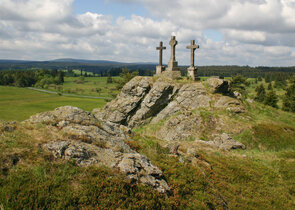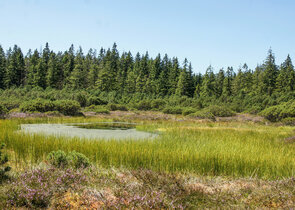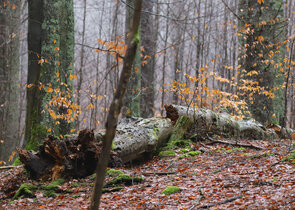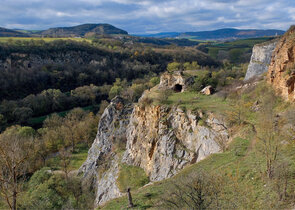Fifty Years of the spa Landscape


The Slavkovský les/Slavkov Forest Mts. is a beautiful area with a rich cultural heritage, where humans have been coexisting with nature since ancient times.
Nature Conservation 2025 — 31. 7. 2025 — On Nature in the Czech Republic — Print article in pdf
The Krušné hory/Ore Mountains Protected Landscape Area?

One of the tasks in the Programme Statement of the Government of the Czech Republic issued in March 2023 is the preparation of documents for the designation of the Krušné hory/Ore Mountains (also known as Erzgebirge) Protected Landscape Area in cooperation with the municipalities and regions concerned. So to what extent has the commitment been fulfilled just now when the Ministry of the Environment of the Czech Republic has announced its intention to designate the Krušné hory/Ore Mts. Protected Landscape Area as a public decree, and how long is the way to really achieving this goal?
Nature Conservation 2025 — 31. 7. 2025 — On Nature in the Czech Republic — Print article in pdf
Decaying Wood – A World of Wilderness

“Mess in the forest! Who has ever seen such a thing, leaving so much wood to rot uselessly!” Such words have been heard in the Šumava/Bohemian Forest Mts./Bohemian Forest Mts. for over thirty years. Fortunately, less and less frequently. Anyone who visits the Šumava/Bohemian Forest Mts. will certainly notice the striking amount of dead wood in the forests, tree rows, on the edges of fields or balks, and in abandoned meadows. Dead wood is primarily produced by nature, but in Specially Protected Areas in the Czech Republic it is also deliberately created by nature conservationists. Wood that has been cut into pieces or possibly debarked, shining in the green of the bilberry bushes, may not seem particularly conservation-oriented, yet it is worth considering why such wood is better than none at all.
Nature Conservation 2025 — 31. 7. 2025 — On Nature in the Czech Republic — Print article in pdf
When Will the Soutok/Morava and Dyje/Thaya Rivers Confluence Protected Landscape Area Be Declared?

In all expert analyses carried out in the last thirty years, the Podluží and the Dyje/Thaya River Floodplain Area below the Nové Mlýny Waterworks (South Moravia) ) was classified as the highest priority for complementing the large-size Specially Protected Area network in the Czech Republic. In addition to including the area into the European Union’s Natura 2000 network, its importance has been confirmed by declaring the Dolní Morava/Lower Morava UNESCO Biosphere Reserve in 2003, thus extending the Pálava/Pavlov Hills UNESCO Biosphere Reserve declared in 1986. Two Ramsar sites/Wetlands of International Importance stretch to the area and its significant parts are also protected by the appropriate cultural heritage legislation. Despite the national and international importance, only 2% of the extraordinarily significant landscape have been included into the Specially Protected Areas.
Nature Conservation 2024 — 30. 5. 2024 — On Nature in the Czech Republic — Print article in pdf
Krkonoše/Giant Mountains Alpine Treeless Areas, Czech Crown Jewels


The Alpine treeless Krkonoše/Giant Mountains., mountain tundra with elements of Arctic tundra, Krkonoše/Giant Mts. tundra, and Krkonoše/Giant Mts. Arcto-alpine tundra are probably the most common designations for the 47 km² of unique ecosystem of international importance with a number of unique features; for example, geomorphological forms of glacial and periglacial origin, azonal habitats of glacial karsts, mountain ridge mires of a subarctic character, springs, dwarf mountain pine or subalpine and alpine grasslands, and with the presence of endemic species and many dozen glacial relics. The Krkonoše/Giant Mts. tundra is one of the most important subjects of protection of the Krkonoše/Giant Mts. National Park, which celebrates its 60th anniversary in 2023. What is its value from the point of view of natural sciences and how is it currently changing?
Nature Conservation 2024 — 30. 5. 2024 — On Nature in the Czech Republic — Print article in pdf
Fifty Years of the Beskydy/Beskids Mts. Protection and Conservation


Half a century. This is the time during which the landscape inhabited by man can change very significantly. Fifty years ago, exactly on 5 March 1973, the Beskydy/Beskids Mountains Protected Landscape Area (PLA) was declared in north-eastern Moravia (Moravian-Silesian Region). At that time, communist regime was “enthusiastically” being built and many currently inconceivable intentions had targeted just the Beskydy/Beskids Mts., e.g. support to building weekend cottages for workers from the Ostrava industrial region there or transformation of mountain pastures and meadows into arable land to compensate fields destroyed during coal mining. New infrastructure was being developed in the valleys, while people were leaving traditional wooden cottages with small fields on the mountain slopes and moving into centres of villages. Therefore, the forest was progressing on the hills as well as constructions in the valleys. Meadows and pastures and consequently, sheep, orchids, and insects were declining. If we look into the 50-year history of the PLA, we will find that some of the requirements for the use of the landscape have been still topical; about others, we only know from eyewitnesses.
Nature Conservation 2024 — 30. 5. 2024 — On Nature in the Czech Republic — Print article in pdf
The Šumava/Bohemian Forest Mts./Bohemian Forest Mts. Protected Landscape Area Celebrates 60 Years

It seems almost unbelievable how long nature conservation has been in effect – and on such a large territory and at the same time so successfully. After all, a national park has been established on most of the territory of the original Šumava/Bohemian Forest Mts./Bohemian Forest Mts. Protected Landscape Area (PLA), and several dozens of new small-size Specially Protected Areas have been designated in the remaining area! Together with the Bayerischer Wald/Bavarian Forest National Park, it is a huge forest ecosystem with high level of protection and conservation: across 417,000 hectares there is no logging, within more than 30,000 hectares there is no game hunting. Therefore, Nature has been building its real cathedral there.
Nature Conservation 2024 — 30. 5. 2024 — On Nature in the Czech Republic — Print article in pdf
Development of an Area after the Fire in the České Švýcarsko/Bohemian Switzerland National Park

Experts in a range of disciplines are currently studying the impacts of the 2022 České Švýcarsko/Bohemian Switzerland National Park fire on different ecosystem components in the fire area, and are also monitoring spontaneous natural restoration there. The present article summarises some of the first empirical observations, which can partly also be seen by visitors to the National Park, and includes several photographs comparing the situation between 2022 and 2023. Exact results of these studies will undoubtedly be the topic of scientific publications after the completion of ongoing research projects.
Nature Conservation 2024 — 30. 5. 2024 — On Nature in the Czech Republic — Print article in pdf
Fragments of Successes from the Landscape of Changes and Stability:

 In 2022, half a century has passed since the colourful limestone landscape nor far from Prague was declared as Protected Landscape Area (PLA). The Český kras/Bohemian Karst is a textbook of changes in nature from the sea with trilobites almost half a billion years ago, to the current overgrowing the landscape and decline in rare species. In contrast to mountainous and remote protected areas, the nature and the landscape have been co-created and shaped by humans over many thousands of years there, and it would be incorrect to consider nature conservation without humans, land managers, and visitors. The article presents half a century of rapid social changes as well as changes in the landscape and nature in this picturesque, dynamic and at the same time in some aspects stable area. Stable with respect to the fact which phenomena have been preserved under the title of the PLA, particularly by recovery and replacement of traditional management.
In 2022, half a century has passed since the colourful limestone landscape nor far from Prague was declared as Protected Landscape Area (PLA). The Český kras/Bohemian Karst is a textbook of changes in nature from the sea with trilobites almost half a billion years ago, to the current overgrowing the landscape and decline in rare species. In contrast to mountainous and remote protected areas, the nature and the landscape have been co-created and shaped by humans over many thousands of years there, and it would be incorrect to consider nature conservation without humans, land managers, and visitors. The article presents half a century of rapid social changes as well as changes in the landscape and nature in this picturesque, dynamic and at the same time in some aspects stable area. Stable with respect to the fact which phenomena have been preserved under the title of the PLA, particularly by recovery and replacement of traditional management.
Nature Conservation 2023 — 5. 6. 2023 — On Nature in the Czech Republic — Print article in pdf
Soil as a Biodiversity Hotspot, Namely that of Small Soil Arthropods

When presenting examples of particularly species-rich ecosystems, we will most probably name tropical coral reefs, tropical gallery forests or selected types of tropical rainforests. To visit these ecosystems, one must travel a long journey far outside of homeland, and even beyond borders of our continent. Still, a comparably species-rich ecosystem can be found, even in our conditions – yet escaping broader awareness when speaking about biodiversity. This is perhaps caused by simple fact, that thousands of species inhabiting this ecosystem could only rarely be observed by the naked eye, as they are mostly of the microscopic size. Indeed, healthy, and well-functioning soil – in our conditions mostly soil of broad-leaved deciduous or mixed forests – is a real biodiversity hotspot reachable just “beyond our courtyards” or next door. Presence of the particular species, overall species richness and relative numbers of soil organisms serves at the same time as great indicator of soil conditions, and often also of the quality of respective above-ground ecosystem at the place.
Nature Conservation 2022 — 25. 5. 2022 — On Nature in the Czech Republic — Print article in pdf

